| Kawasaki Heavy Industries (KHI) C151 | |
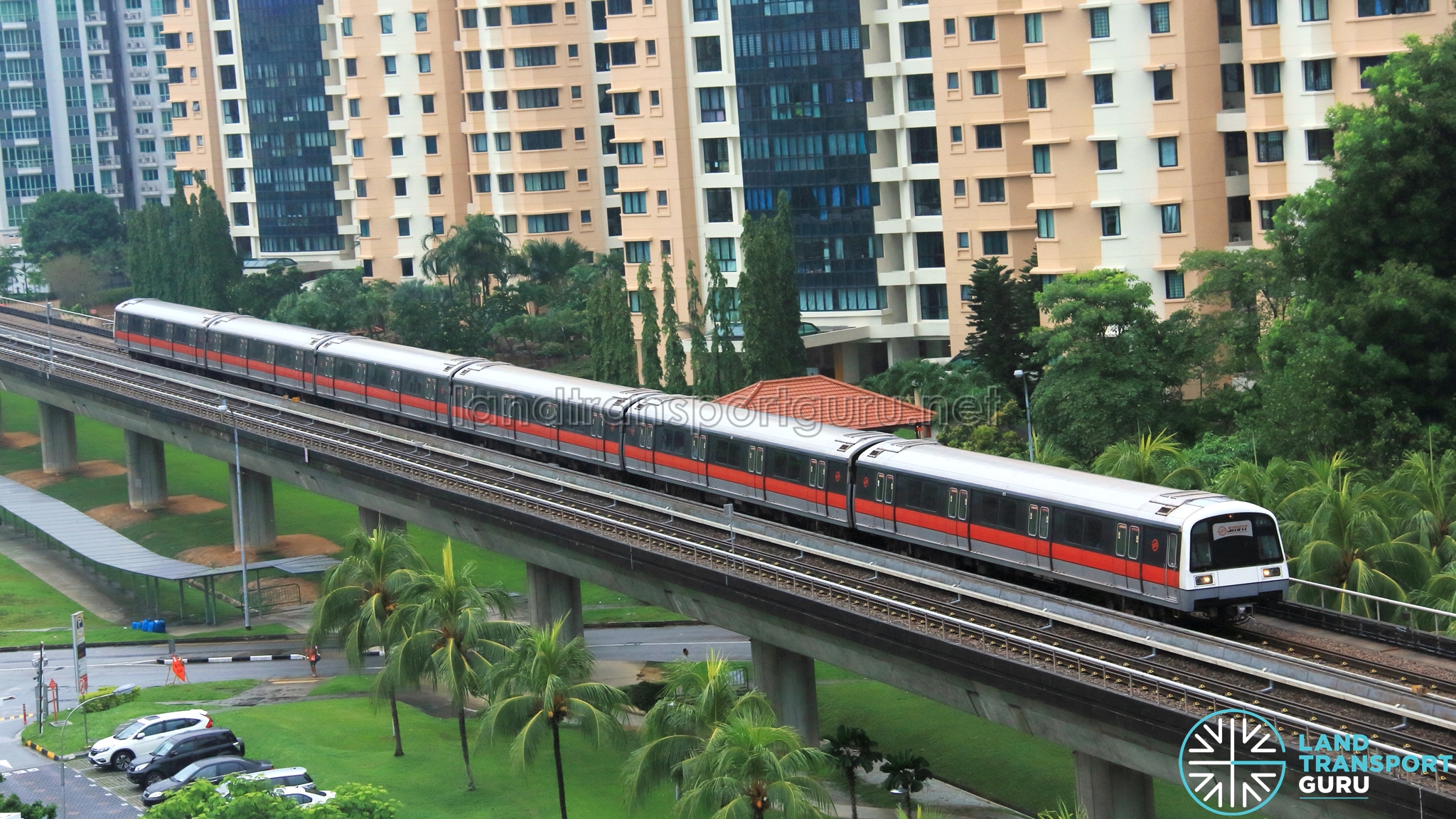 |
|
| In service | November 1987 – September 2025 |
| Manufacturer | Kawasaki Heavy Industries (with Nippon Sharyo, Tokyu Car Corp, and Kinki Sharyo) |
| Constructed | 1986 – 1989 |
| Number built | 396 vehicles (66 trainsets) 4 vehicles (money train) |
| Formation | 6 cars per trainset DT–M1–M2–M2–M1–DT |
| Fleet number | 001/002 – 131/132 |
| Operators | SMRT Trains |
| Depot(s) | Bishan, Changi, Tuas and Ulu Pandan |
| Line(s) served | North South Line & East West Line |
| Technical Data | |
| Car body | Double-skinned Aluminium-alloy |
| Doors | 8 per car |
| Electrification | 750 V DC Third rail |
| Track gauge | Standard Gauge (1435mm) |
The Kawasaki Heavy Industries C151 was an electric multiple unit (EMU) train operating on the North South Line (NSL) and East West Line (EWL). Entering service in 1987 in tandem with the opening of Singapore’s Mass Rapid Transit (MRT) system, these trains are the oldest rolling stock currently in operation.
Sixty-six trainsets were procured, each formed of six carriages, along with a single four-car set formerly used as a money train. They were manufactured from 1986 to 1989 by a Japanese consortium led by Kawasaki Heavy Industries, and joined by Nippon Sharyo, Tokyu Car Corp (now J-TREC) and Kinki Sharyo.
Between 2006 and 2008, all trains underwent mid-life refurbishment works led by Hyundai Rotem. A partially-completed End-of-Life Upgrading Project was shelved in 2016 when the Land Transport Authority (LTA) decided to procure new R151 trains in favour of refurbishing the C151 trains. Retirement of C151 trains began in 2020.
All trains were officially retired on 28 September 2025 after a commemorative ride event, with the last revenue service day on 26 September 2025.
In September 2025, 2 trains (015/016 & 085/086) were transferred to East Coast Integrated Depot for testing purposes.
Background
Initiated in 1983 whilst MRT construction was ongoing, Contract 151 (C151) for the procurement of rolling stock was called for 150 train cars with an option for 246 more. In the highly competitive bidding that followed, a Japanese consortium led by Kawasaki Heavy Industries (along with Nippon Sharyo, Tokyu Car Corp and Kinki Sharyo) was awarded the contract in 1984, for 396 train cars at a cost of S$581.5 million.
These trains were built in Japan by all four companies between 1986 – 1989, to agreed specifications. As a result, there are no comparable differences between all trains. Each 6-car train is actually two 3-car trainsets coupled together, each comprising of a Driving Trailer (DT) and two Motor Cars (M1 and M2).
Technical Information
On the exterior, trains are coated in an aluminium shot-peened surface. The train employs Direct Current (DC) motors which incorporate a 4-quadrant GTO chopper control system and regenerative braking for high energy efficiency. Although the reliability of the Gate turn-off (GTO) thyristor system was not well proven at the time, the decision to adopt it was sound and resulted in cost effectiveness.
The chopper control system propels trains using high power electronic switching devices to save energy and give passengers a smoother ride.Regenerative braking tales advantage of braking to return power to the system. Coasting (running without motor power) after high acceleration over a short section also saves energy.
History
The first train was delivered to MRT Corporation (MRTC) on 8 July 1986 at Bishan Depot. These trains entered revenue service on 7 November 1987 with the opening of the North South Line between Yio Chu Kang and Toa Payoh. The exterior was clad in shot-peened aluminium alloy, appearing as silver with a central red stripe running the length of the train. On the interior. each car featured a different colour scheme, namely orange, blue and green from each end to the middle cars.
Between 1992 and 1994, all trains were installed with message synthesisers that automatically played announcements following a successful trial in 1990. This eliminated the need for train operators to manually announce arriving stops.
Mid-life refurbishment works were carried out between 2006 and 2008 by Hyundai Rotem, Mitsui, RM Transit Technology and Lexbuild, at a cost of S$142.7 million. The exterior was painted in black with stripes of red and grey similar to the C751B trains. On the interior, wider seats were installed, with 7 seats in between doors, down from the previous 9, and two wheelchair spaces were added in the middle 2 carriages. In addition, interior fittings were replaced for a fresh new look, along with many other running components. Brighter saloon lighting, line flow fans, an improved PA system and trifuricated grab poles were among the new features.
In 2008, SMRT Corporation and the Land Transport Authority (LTA) announced that ten C151 trains would have two rows of seats removed from the middle of every car, creating a standing area that would fit more commuters during the peak hours. By 2015, all trains were modified to this standard. Also in 2008, the SMRT Active Route Map Information System (stylised as STARiS) was first trialled on trainset 053/054, consisting of 4 Vacuum Fluorescent Displays (VFD) mounted near the ceiling and 8 active route maps mounted above every door in each car. It was progressively installed on all C151 trainsets from 2009 onwards.
In 2013, SMRT announced an End-of-Life Upgrading and PMSM retractioning project that planned to replace the legacy DC traction motors and 4-quadrant/GTO chopper controllers from Mitsubishi Electric with PMSM traction motors and IGBT-VVVF controllers from Toshiba. This upgrade would reduce power consumption by 30%, noise levels by 12 dB and be easier to maintain. These upgrades were part of a planned replacement of all major engineering components on all C151 trains planned for completion in 2019. Train sets 055/056 and 131/132 received the new motors as a trial and were placed on revenue service in July 2015.
Between 2014 and 2015, all C151 trains were upgraded with Thales SelTrac Communications-Based Train Control (CBTC). Additional signalling equipment was installed at both ends of every train, replacing 2 seats at each end with a signal box. Also in 2014, two additional rows of handgrips were progressively installed.
Despite SMRT having already purchased the PMSM propulsion system and committed to its installation, plans were put on hold when LTA announced its intention in July 2016 to acquire all of SMRT rail assets on 1 October 2016 under the New Rail Financing Framework.
Instead of continuing with the planned upgrades, all C151 trainsets were to be replaced with new Contract R151 trains as announced on 28 October 2016.
As such, only 6 C151 trains received the IGBT-VVVF traction upgrade and PMSM motors. These trains are:
- 025/026
- 055/056
- 065/066
- 095/096
- 109/110
- 131/132
In October 2024, Transport Minister Mr Chee Hong Tat mentioned in a Parliamentary Ministerial Statement that an independent assessor had assessed the structural integrity of the C151 trains, whom concluded that the trains have a total service life of 38 years. He also mentioned that the plan was to replace the trains by end-2026, before these trains reach their 38-year service mark.
The trains were last spotted on revenue service on 26 September 2025. Thereafter, a special KHI C151 Commemorative Ride for Friends of SMRT took place on 28 September 2025, operated by trainset 089/090.
Current Design
All C151 trains are comprised of six cars with open gangway connections between all cars. Each car has eight doors, four on each side. The interior features longitudinal seating in three colors: red, blue and green from the end cars to the middle cars. Wheelchair bays are located in the middle of each train, at doors 12 and 13. Priority seats are located in every car, near the doors. All trains are equipped with STARiS, SMRT’s active route information system comprising ceiling-mounted textual displays and active route maps above every door.
Emergency Exits are located at both ends of every train, with a ramp that can be deployed in an emergency. Within the cabin, Emergency Communication Buttons are located at the side of the train doors, enabling passengers to speak with staff in an emergency. Fire extinguishers are also placed in every car.
Train Formation
A six-car trainset is formed of two three-car sets permanently coupled together. Each set comprises one driving trailer (DT) and two motor cars (M1 and M2). As such, the running configuration of a C151 trainset is DT–M1–M2–M2–M1–DT.
Every car is identified by a four-digit number ranging from x001 to x132, where the first digit x is carriage identifier. The driving cab is 3, followed by the second car using 1 and the third car using 2. The last three digits refer to the 3-car trainset of which the train is comprised of. SMRT’s 66 trains are actually 132 3-car trainsets coupled together in an even-odd arrangement, i.e. Set 001/002, Set 003/004 and on to Set 131/132.
As such, a sample Set 001/002 will contain the carriage numbers 3001-1001-2001-2002-1002-3002. Depending on the direction of travel, the sequence may be reversed. On rare occasions, trainsets may be cross-coupled.
All trains were construction by four Japanese manufacturers as follows:
- Kawasaki Heavy Industries built sets 001–020, 051–062, and 093–102
- Kinki Sharyo built sets 021–030, 063–072, and 103–112
- Nippon Sharyo built sets 031–040, 073–082, and 113–122
- Tokyu Car Corporation built sets 041–050, 083–092, and 123–132
Money Train
A four-car money train, set 301/302 manufactured by Kawasaki Heavy Industries, was in service from 1987 to 2007. After being decommissioned in 2007, two cars were relocated to Singapore Armed Forces (SAF) training grounds and can be seen on Google Satellite view, northwest of the National Shooting Centre. (GPS Coordinates: 1.376328, 103.677889)
Derailment
On 25 September 2024, trainset 065/066 developed a fault while travelling eastbound on the East West Line near Clementi station. Passengers were detrained at Clementi station and SMRT then proceeded to withdraw the train towards Ulu Pandan Train Depot.
A defective train axle box on the train dropped, causing one bogie to come off the running rail between Dover and Clementi stations. This resulted in track equipment being hit, including the third rail and point machines, leading to a power fault caused trains on the EWL between Queenstown and Boon Lay stations to stall.
From checks by SMRT & LTA engineers, 34 rail breaks across 1.6km of tracks between Clementi and Dover stations were detected, along with damage to 3 point machines, the third rail, as well as power cables and rail clips.
Train services were only resumed on 1 October 2024.
Main Article: Faulty C151 Train Causes Extensive Damage & Disruption to EWL Services
Disposal of Decommissioned Trains
Main Article: Decommissioning of C151 trains
In May 2019, LTA called a tender for the disposal of 66 C151 trains under Contract R151D – Disposal of Decommissioned Trains. This tender was awarded to Toyotron (Pte.) Limited at a price of S$828,000.00 (Payable to LTA) on 16 December 2019.
The retirement of C151 trains formally began in 2020. Authorities have added that they were open to proposals from public and private organisations that sought to repurpose these old cars that would otherwise be scrapped, such as for education and training purposes as well.
On 5 March 2022, cars 3095 & 1095 (part of trainset 095/096) were moved to Changi Exhibition Centre to be part of the film set for ThirdRail, while car 2095 was sent to Toyotron Pte Ltd for scrapping.
Cars 3003, 1003, 1004 & 3004 are preserved at SAFTI City for military training purposes.
Car 3097 is likely preserved at Nee Soon Camp for military training purposes.
Car 3032 is preserved at St. Andrew’s Community Hospital (Bedok).
According to an article on Lianhe Zaobao, an LTA spokesperson mentioned that 2 first-generation (C151) trains will be sent to the Singapore Rail Test Centre for testing purposes.
These older trains, with their simpler design, utilize simulated systems that make them more suitable for testing new metro technologies and equipment, such as air conditioning, braking, and pneumatic systems, which are intended for newer trains.
Coupled Trainsets
In the event of a train fault, a working train can be used to haul a faulty train back to the depot by means of coupling.
The following pictures were taken on 13 February 2017, where a faulty train on the North-South Line led to service delays during the morning peak hour. The faulty train was stopped at Jurong East Station, and returned to Ulu Pandan Depot in a 12-car formation.
Gallery:
External Links & References
Back to Trains

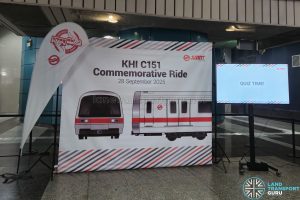
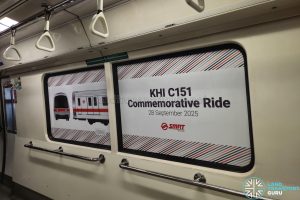
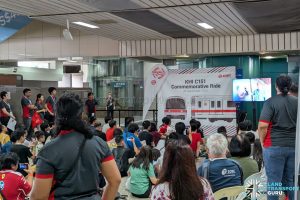


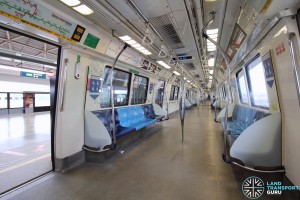
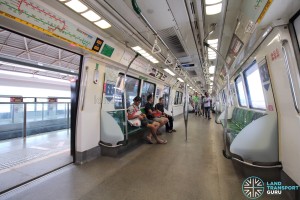

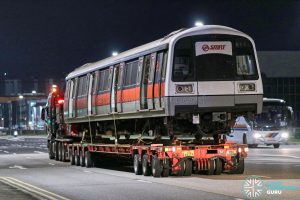
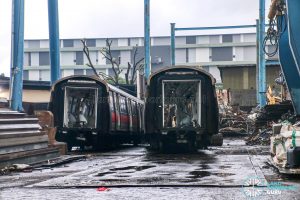
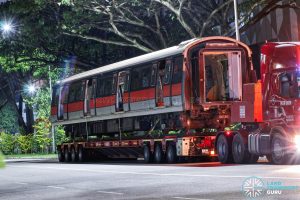
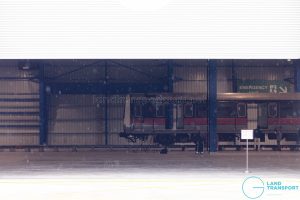
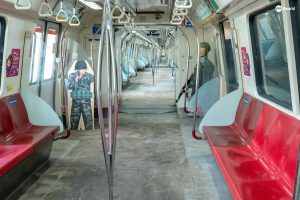


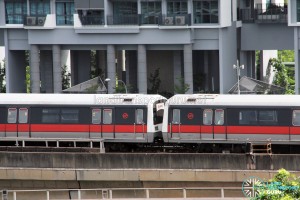
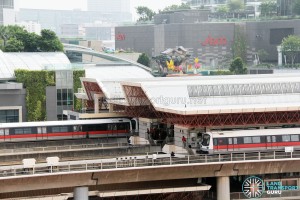
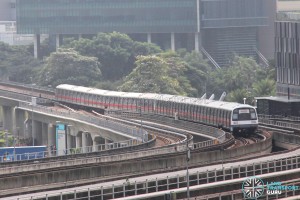
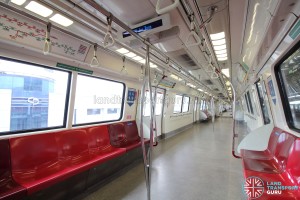
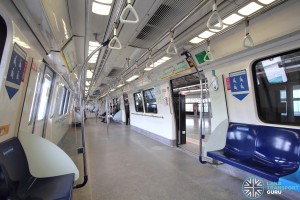
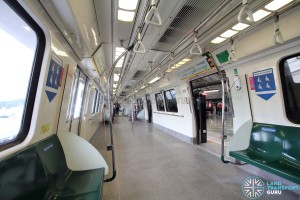

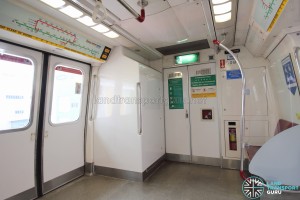
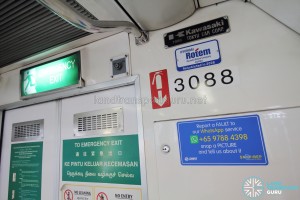
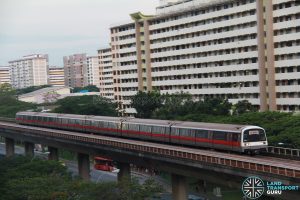
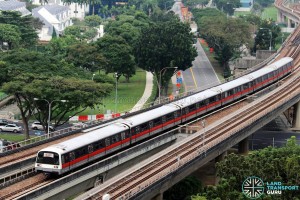


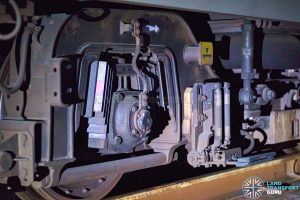
i wish they still had the C151 🙁